Speech Reserve Bank Domestic Operations under RTGS

Frank Campbell
Head of Domestic Markets Department
Remarks to the AFMA TechnoFuture '98 Seminar Program
Sydney –
Real-time Gross Settlement (RTGS), it is fair to say, was motivated primarily by broad prudential considerations, mainly the desire to minimise the potential for disruption in the payments system in Australia. RTGS has achieved this by greatly reducing settlement risk in high-value domestic payments.
The value of payments through RTGS has averaged about $110 billion a day (excluding intra-day repos); payments have exceeded $150 billion on some days (Graph 1). In other words, the equivalent of annual GDP is turned over in the RTGS system in about a working week. The RTGS system now handles about 90 per cent of the total flow of payments between members of the Reserve Bank Information Transfer System – RITS – which is the operating framework to achieve settlement within RTGS. Membership of RITS is composed of all of the major financial institutions in Australia, about 230 organisations in all. Flows on such a scale between such diverse institutions could not be handled save by the sort of technology now in operation.
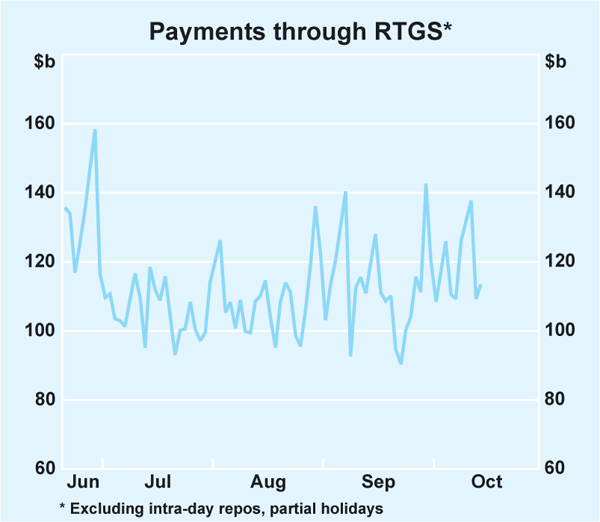
The scale of the RTGS system itself understates its value to the financial system, since it also has in-built features to help control risks of various kinds. Needless to say, the RITS system itself, and in-house systems of banks, will only achieve the reliability required if they are maintained in good order. On that score, the Reserve Bank, in its role as system administrator of RITS, has held discussions with banks to ensure that effective lines of communication between the Reserve Bank and banks will remain open, if the RTGS system comes under stress due to technical malfunction as may occur from time to time.
I have little, if anything, to say about this technology, except to note that it is an application which has both prudential and market efficiency benefits. To that extent, its introduction should be applauded by regulators and market participants alike. Australia's RTGS system is among the most advanced in the world.
The perennial struggle in the regulatory sphere is to design policies that achieve a workable trade-off between – on the one hand – soundness of the financial system and – on the other – the efficiency of the system.
Taking as given that RTGS is a great leap forward in handling settlement risk, I intend to see what I can say about an aspect of the efficiency of the system – namely the management by financial institutions of their cash operations. I have chosen this as the focus of my comments partly because there is a good story to tell, and partly because it should not be left out of any evaluation of RTGS.
RTGS affects how banks manage their liquidity, both over time and through each day. Accordingly, these comments fall naturally into two parts:
- first, the provision of system-wide liquidity; and
- second, the provision of intra-day liquidity.
I intend to talk mainly about the Reserve Bank's role in providing liquidity. But there are some observations too about how banks have responded to RTGS. At this stage, of course, we have had only four months' experience with the new system: while this is too short a time in which to draw strong conclusions, some clear patterns have emerged.
System Liquidity
The cash market itself, and its evolution, is of interest to the Reserve Bank to an extent that goes well beyond the Bank's responsibility as the RITS system administrator. The Bank implements monetary policy through daily operations in the market for short-term funds. The stance of monetary policy is expressed in terms of a target for the cash rate – that is the interest rate on overnight loans between financial institutions, which is determined in the cash market.
Within the Reserve Bank, high priority in the development phase of RTGS was given to ensuring that the new arrangements would not impede the effective implementation of monetary policy. In other words, we expected that the new system would permit the Bank to operate in the market each day to provide adequate liquidity to ensure that banks and non-banks trading in the cash market would be able to complete settlement at a cost of funds around the cash rate target.
Banks settle transactions across accounts they hold at the Reserve Bank; these accounts are known as Exchange Settlement (ES) accounts. While banks hold buffers of liquid assets which can, in principle, be converted readily to cash, liquidity in the financial system – defined as funds available to make immediate payment – is ultimately measured by balances that banks hold in their ES accounts.
Liquidity is not free. Exchange Settlement balances have an opportunity cost which might be approximated by the difference between the interest rate banks would earn by investing overnight in the market, and the rate paid on balances held at the Reserve Bank. At present, this difference is 25 basis points. An efficient settlement system should enable banks to minimise the precautionary settlement balances they hold, and thereby minimise this cost.
To date, the RTGS system seems to meet this test (Graph 2). Banks, in aggregate, now hold lower levels of settlement balances than in the settlement regimes which RTGS superseded. When the group of authorised money market dealers was a conduit between the Reserve Bank and the banking system, banks held an average of over $4 billion in settlement balances with the authorised dealers. After the authorised dealers were abolished, and the Reserve Bank began to pay interest on ES balances, the level of settlement balances rose, to a peak of $10 billion in June 1997; after some finetuning of these arrangements, these balances fell to about $2 billion just before RTGS was introduced.
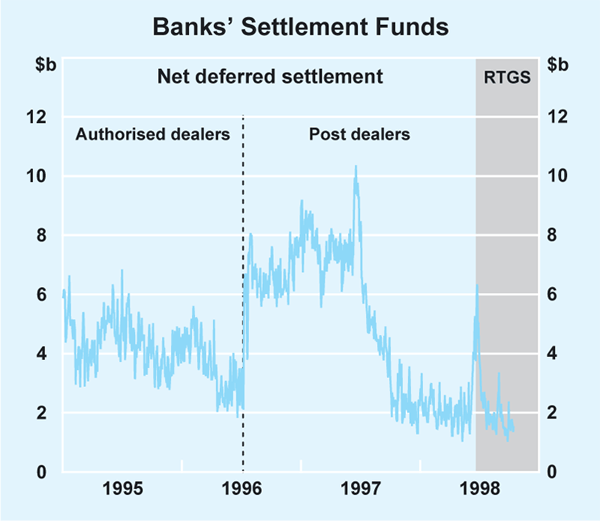
As RTGS was introduced, banks' raised their holdings of ES funds to a total of $6 billion as they became more cautious. The situation was aggravated by a period of heightened volatility in financial markets and the approach of financial year-end. As banks have grown more accustomed to RTGS, however, ES balances have moved to an average level of about $1½ billion over the past month.
From the perspective purely of efficiency, the low level of ES funds under RTGS is reassuring. Because of uncertainty about the size and timing of payments under RTGS, some commentators had foreseen a situation in which banks would seek to hold high levels of ES funds, raising banks' costs. This has not occurred. It seems likely that the drop in settlement balances owes importantly to an increased focus by banks on liquidity management; this is, of itself, highly desirable.
It would be misleading to leave the impression that banks' liquidity management ends with management of ES funds. Banks these days have diverse systems for managing liquidity. While these systems are difficult to encapsulate in a single measure, a traditional way to look at bank liquidity is to look at their holdings of cash plus others assets which the Reserve Bank would accept in exchange for ES funds (Graph 3). While these holdings have tended to fall relative to banks' total assets, as regulatory requirements have been eased, banks still hold between 5 and 6 per cent of assets in highly liquid forms.
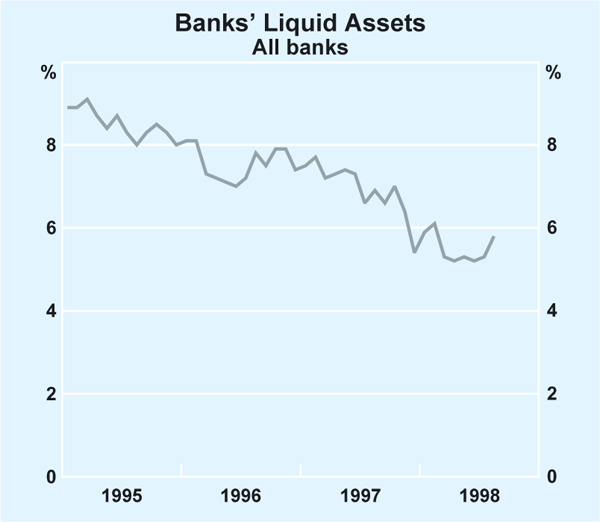
Notwithstanding the slim layer of ES balances, the cash rate has been well behaved (Graph 4): since RTGS was introduced, the cash rate has tracked a steady path near its target, as it has for much of the past decade. This is the only genuine barometer of the effectiveness of the Reserve Bank's market operations, since these operations are aimed at maintaining stability in the cash rate – not in achieving a particular level of ES funds.
The 11.00 am cash rate shown on Graph 4 is the traditional measure of overnight interest rates. (The series here is an amalgam of the rate which appears on Reuters screens on days when it is actually published, and the Reserve Bank's reading from the market at midday on other days.) The second measure shown for recent months is the interbank overnight interest rate, which is a weighted-average interest rate based on the rates at which the largest dozen or so banks in the RTGS system borrow and lend overnight ES funds among themselves. It is a better measure than the 11.00 am rate of cash market conditions over the day.
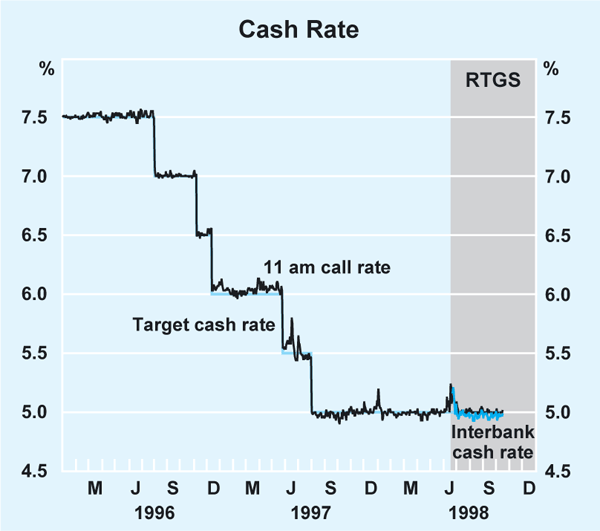
Both rates have tended to average around the target of 5 per cent.
Again this is a better outcome than might have been expected. Some commentators had predicted greater volatility in the cash rate due to unpredictable payments flows. Low levels of ES funds might generally raise concerns that any lurch in the demand for cash would result in high volatility in the cash rate. Our experience is different from this: we have found that relatively low levels of ES funds give the Bank considerable leverage over cash conditions, and the market seems to have confidence that the Bank operates continually to stabilise this rate around its target.
The combination of low levels of ES funds and the cash rate remaining close to its target suggests a couple of conclusions: first, the market players involved with RTGS have adapted well to operating in the new environment; and second, participants have reasonable confidence about the availability of cash near the interest rate announced by the Reserve Bank as its policy target. This confidence partly reflects design features contained in RTGS which promote liquidity, and about which I will talk shortly.
More importantly, the satisfactory transition to RTGS to date primarily reflects the willingness of market participants to embrace such a sweeping change, and work effectively within the new regime.
The transition has also been helped by the Reserve Bank adapting its own dealing operations. Two particular measures seem to have helped build confidence in the system. First, the Bank has been prepared to respond to cash conditions as the day unfolds by conducting a second round of dealing, if necessary. This has usually involved a second operation to add cash because the market has turned out to be tighter than was expected at the time of our morning liquidity operation.
The main factor causing such unexpected tightness has been unanticipated shifts in the demand for liquidity; these shifts are driven by the market itself, often in response to general market developments, the nature of which is inherently unpredictable. Unforeseen instability in the foreign exchange market or in overseas capital markets, for example, has tended to see demand for cash rise.
The Reserve Bank has undertaken a second round of dealing on fewer than 20 occasions over the past year. The frequency of such dealing rose as RTGS was phased in. But, after this short phase, as banks have become more familiar with the intra-day pattern of payments, the Reserve Bank has dealt a second time on only three occasions. The market also seems to accept the idea that such operations are exclusively for liquidity management purposes, and contain no messages about monetary policy.
The other new feature of the Reserve Bank's dealing arrangements is the overnight standby facility. Whereas second rounds of dealing are open to all RITS members, the standby facility ensures that funds are available to banks to meet unexpected calls on them late in the day. This facility recognises the vital role that banks perform in completing settlement, and the funding risks they face in doing so. The standby enables banks, at their discretion, to access overnight repurchase agreements with the Reserve Bank, at 25 basis points above the cash rate target.
Since early May, 12 banks have used the facility, for an average borrowing of about $100 million each. On each occasion, these repos have been reversed in full the next working day. Use of the standby facility – as with second rounds of dealing – has become somewhat less frequent as RTGS has been bedded down.
There are two general points to make about banks' use of the standby facility. First, the facility itself is part of the overall structure of the RTGS system designed to provide banks with confidence that adequate liquidity will be available at reasonable cost. In the normal run of things, any recourse to this facility will simply reflect the fact that banks have been playing their role in making liquidity available to the financial system more generally. Without the standby, and without banks' willingness to use it on occasion, the RTGS system itself might work a bit less smoothly than has been the case.
The second point is that the overnight repo is essentially to help deal with unexpected, and relatively infrequent, shortages of settlement balances in a particular institution towards the end of the day. The Bank would not wish to see individual banks make use of the facility as a consistent source of funding. The interest rate incurred in using the facility is designed to discourage undue reliance upon it.
My comments so far have mainly been about how the Reserve Bank operates to provide system liquidity. The Bank is the ultimate source of ES funds for the banking system as a whole. Accordingly, its market operations are directed at ensuring that liquidity, in aggregate, is sufficient. But these operations cannot ensure that liquidity is efficiently distributed through the market.
The market has the leading role here. Banks, of course, have sophisticated liquidity management systems, involving operations which extend well beyond their management of ES funds. They include borrowing and lending through the secured and unsecured money markets, and the foreign exchange swap market, as well as managing short-term assets. An active market in overnight unsecured ES funds is now also evident.
A group of a dozen or so larger banks provides the Reserve Bank with figures on their borrowing and lending of ES funds each day. Overnight unsecured borrowing of ES funds among this group is shown in Graph 5, expressed as a ratio to banks' end-of-day holdings of ES funds.

This group of banks now turn over ES balances in the system about 1½ times each day. The rise in this ratio is another sign of market efficiency under RTGS since it suggests effective recycling of ES funds among banks, which permits the financial system to operate with a lower level of ES balances than would otherwise be required.
The other important aspect of liquidity management under RTGS is management of intra-day liquidity.
Intra-day Liquidity
Because payments are made continuously through the day, intra-day demand for liquidity exceeds the demand for end-of-day ES balances. The Reserve Bank intra-day repo facility – which is available, at no interest cost, and at banks' discretion – is the main instrument available within RTGS for providing intra-day liquidity.
Use of intra-day repos gradually increased in the implementation phase of RTGS, and reached a level of $4½ billion a day at the time that RTGS was introduced (Graph 6). As banks subsequently worked to reduce high levels of ES balances, they made less use of this facility. Once ES balances returned to more normal levels, use of intra-day repos picked up again; banks have recently undertaken about $5½ billion a day, or about 5 per cent of total daily RTGS payments. The combination of low overnight ES balances and greater recourse to intra-day repos is a more efficient, and less costly, approach to liquidity management for banks, compared with the situation in July with relatively high ES balances and low intra-day repos.
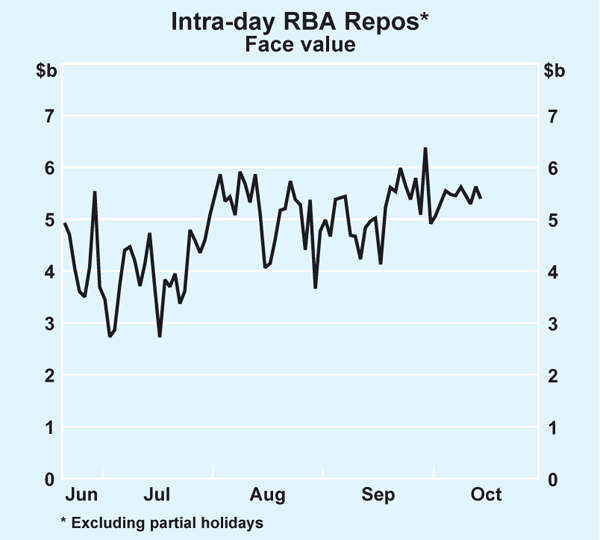
The system seems to have run smoothly, on relatively low levels of within-day funds, partly because other features of the RTGS system have worked effectively. These include:
- an auto-offset facility which monitors and automatically settles offsetting payments between banks on a bilateral basis, subject to various limits;
- an efficient queuing mechanism, which allows small payments to leapfrog large payments if sufficient liquidity is available to settle them; and
- automation of within-day customer credit checks and liquidity management.
Each of these features helps banks economise on their use of liquidity.
Among banks, there seems to have been a change in how funds are managed over the day. The main factor here – again – has been uncertainty about the timing of payments. Some banks initially responded to this unpredictability by holding on to ES balances and delaying payments. While the individual banks concerned were more liquid, this sort of behaviour tended to reduce liquidity of the rest of the system.
Clearly, there are important externalities in the RTGS system: what might constitute optimal liquidity management for an individual bank will not always be an efficient outcome for the system as a whole. If the behaviour just described were widespread, there would be potential for a kind of self-imposed gridlock. Fortunately, to the extent that it has occurred, such behaviour now seems less apparent.
More generally, the pattern of trading in cash has changed noticeably, with more trading now taking place quite late in the day. The recent pattern reflects the fact that banks cannot be certain about their funding needs until settlement is completed. As a result, they tend to hold a buffer of spare cash until they are confident about end-of-day positions.
More recently, as banks have become more confident that sufficient funds will be available and that the market will redistribute them efficiently, they seem to have become more willing to make surplus funds available earlier in the day. The Reserve Bank welcomes this, since it enhances the efficiency of the wholesale cash market generally, which, in turn, promotes the efficiency of our own operations.
Conclusion
In concluding, let me say that the introduction of RTGS from the perspective of the Reserve Bank's operations has proceeded well. It has put no impediments in the way of effective implementation of monetary policy. The cash market itself seems also to have adjusted to the new regime.